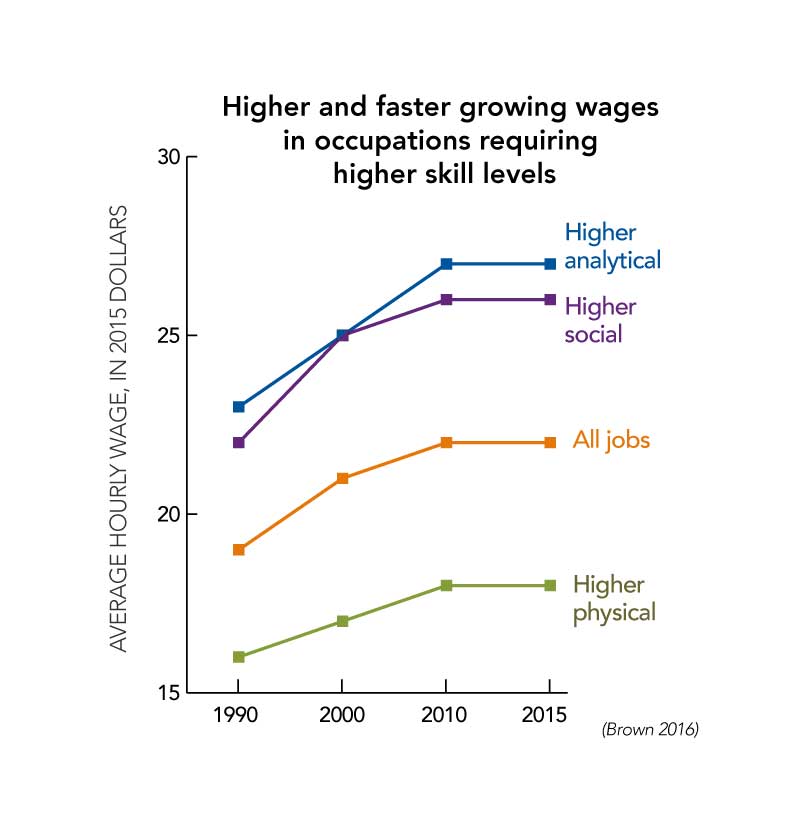According to the United States Census Bureau and recent trends, several things are clear:
- Medium- and low-skilled manufacturing jobs are decreasing in number across the U.S. This is due to increased use of automation and the "off-shoring" of many companies to overseas locations.
- Retail service is decreasing as more people are shopping with the online giants and no longer need to see, touch, and try on items—sellers don't need large showrooms and personnel.
- Medium-level service jobs are decreasing as they are being replaced by automated customer service systems.
Let's look more closely at these trends and what is driving them. It's clear that automation is being used to do more jobs. The types of jobs that are easy to automate are those that are routine and repetitive.
It's not only low-skilled factory workers whose jobs are being lost to automation; it's also many of what used to be middle-skill, middle-income jobs. These include check-out clerks, bank tellers, administrative assistants, bookkeepers, tax preparers, data entry operators, telemarketers, insurance underwriters, photo processors, library technicians and cargo agents.
This trend is leading to a "hollowing out" of the job market, with fewer jobs that require a medium level of skill and at one time provided middle America with a living wage.
What remain are a smaller number of high-skill, high-income, "high-tech" jobs and lots of low-skill, low-income, "high-touch" jobs.
1. Examples of "high-tech" jobs are engineers, software designers, architects and scientists. These jobs require college degrees or higher.
2. "High-touch" jobs require the person to be in close personal proximity and may require physical strength and dexterity. Examples of the "high-touch" jobs that are plentiful are farmworkers, food service personnel, carpenters, plumbers, electricians, landscape workers, security personnel, and cleaning and janitorial workers.
While this may seem to paint a grim picture, fortunately, there are other industries where workers are in demand and the demand is increasing.
Personal care service workers are increasing in demand as expectations rise for fitness, health, nutrition and therapy among all age groups. Some examples are dieticians, nutritionists, fitness specialists and massage therapists.
Jobs in renewable energy are increasing, as more businesses and families opt for sources such as solar and wind. Some examples are operations service analysts, mathematicians, software developers and analysts, solar photovoltaic installers, statisticians, and wind turbine service technicians.
Jobs in the health care field are not only increasing but exploding as the baby boomers enter their senior years and need medical care. The health care industry offers many excellent examples of well-paying jobs that require both technical and interpersonal skills. Some examples are dental hygienist, dental technician, emergency medical technologist, genetic counselor, nurse's aid, nurse educator; nurse practitioner; nurse technician; occupational therapist, phlebotomist, physical therapist, physical therapy assistant, physician's assistant, radiology technician, rehabilitation counselor, speech pathologist and speech therapist.
The graph below shows that occupations requiring analytical and social skills have higher wages than those that require physical labor alone.

Photo courtesy of Penn State Better Kid Care.
Some of these jobs don't require a four-year college degree, but they do require at least some specialized education after high school, such as a one-year certificate, an Associate Degree or a certified apprenticeship.
What this suggests for educators wanting to inject career preparation into their regular curricula is that they need to do three things:
- Increase the level of science, technology, engineering, and mathematics (STEM) understanding and hands-on learning, to prepare youth for "high-tech" jobs.
- Boost social and emotional learning (SEL) and practice, to prepare youth for "high-touch" jobs.
- Encourage all youth to continue in some type of specialized training beyond high school, to be prepared with the skills they will need for the new economy.
For an in-depth look at how afterschool programs can add a focus on career preparation to their curriculum, take this Career Preparation in Out-of-School Time Programs online module.
Want to learn more about youth development topics and receive professional development credit? Penn State Better Kid Care provides free* online professional development modules accessible anywhere, anytime for childcare and school-age professionals. Approximately 100 hours of school-age professional development are available, including topics in PYD, SEL and STEM. These modules are approved for professional development in 49 states. Access the modules.
*There is no charge to read the content, view the videos, and download and print the activities. To take the assessment and receive a Certificate of Completion, you will be prompted to pay a $5.00 fee.
Eileen Wise is a youth development specialist at Penn State Better Kid Care and primary author of the PYD series and other modules for school-age professionals.
Additional Sources
Brown, Anna. 2016. "Key findings about the American workforce and the changing job market." Pew Research Center.
Pew Research Center. 2017. "Manufacturing output has grown over the past three decades, even as payrolls have shrunk."
The United States Census Bureau. 2012. "Measuring America: The Changing U.S. Economy."




